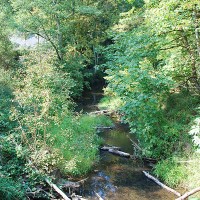Now is the time to be thinking about planting trees and shrubs along your streamside area, otherwise known as the riparian area. Healthy riparian areas have dense native vegetation and are free of non-native invasive species like English ivy and Himalayan blackberry.
Plants provide benefits
Properly functioning riparian areas provide many benefits. They keep streams cool by providing shade. Plants with strong root systems hold stream banks in place, keeping soil out of streams. The plants along streams also provide protective, nourishing habitat for fish and wildlife.
Dormant plants are less expensive
The best time to plant trees and shrubs are when they are dormant (not actively growing), typically between November and March. This is when bare root plants, which are less expensive than potted plants, are available. When preparing to plant, strongly consider using native vegetation. Native plants are adapted to our local soils and moisture conditions, and provide food and habitat for our resident birds and wildlife.
Find native plants locally
Native plants are available at many of our local nurseries. For information on local nurseries that sell native riparian plants, visit www.plantnative.org. Plants may also be purchased plant sales held by several Soil and Water Conservation Districts (SWCDs) in the Portland area. These neighboring soil and water conservation districts offer native plants at seasonal sales:
- East Multnomah Soil and Water Conservation District
- Marion Soil and Water Conservation District
- Yamhill Soil and Water Conservation District
There are a wide selection of trees and shrubs that are suited to life here in northwest Oregon. A few to consider are red osier dogwood, western red cedar, vine maple and snowberry. To find out the best species to use in riparian and other wet areas call your local soil and water conservation district. In Clackamas County, contact Jenne Reische at the Clackamas County SWCD.


